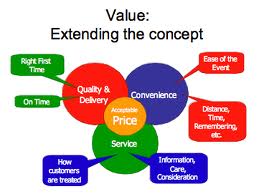What does it mean to create value?
What are you doing to create value? I’m sure you’ve heard, as I have, that business is all about creating value for those around you. I recently saw a post by Robin Sharma on five points to protect your company. The fifth point he made was: Become Obsessed with Value Creation. The point says “This is not some pie in the sky idea. It’s a hard hitting business growth tactic. Obsess over how you can add more value to more people and the revenues will take care of themselves.”
My success coach, Steve D’Annunzio, talks about value from 2 points of view: subjective and contextual. He says that “we are moving out of the age of information and moving into an age of context” and “that no truth exists without context”. For example, let’s look at the context of a simple drug like pain medication. It can make you feel better from that kidney stone, but it can also become an addiction or it could alter your mind to the degree of committing suicide.
In the age of information, Steve defines value as a product, service or idea that eliminates threats, fulfills obligations or capitalizes on opportunities. In the age of context, it is defined as any product, service or idea that energizes and empowers you MORE than the energy, time or money that you spend to get it.
 So what does value mean to you? How do you know when you’re providing value to your customers? I would say that increasing business is a good indicator. When your customers are waiting in line for your product or service, you are adding extreme value (think Apple). If you’re seeing a declining customer base and decreasing profits, it’s probably a good time to start asking your clients how you can provide them more value.
So what does value mean to you? How do you know when you’re providing value to your customers? I would say that increasing business is a good indicator. When your customers are waiting in line for your product or service, you are adding extreme value (think Apple). If you’re seeing a declining customer base and decreasing profits, it’s probably a good time to start asking your clients how you can provide them more value.
From my experience, you have to have thought and desire to find value. Sometimes it slaps you in the face with a client ranting “why the heck doesn’t your service allow this?” If it’s not slapping you in the face, simply ask your clients what they need from you that would eliminate a threat, fulfill an obligation or capitalize on an opportunity. Sometimes clients just don’t know what they will find valuable until they have it.
The book Blue Ocean Strategy has an exercise that can come in handy to help find the value that you or your clients don’t currently see. This is a great book, filled with lots of insight on how to swim out in the vast blue ocean of competitors instead of floating around in the red ocean of shark infested competition. Next week I will go further into value creation from the Blue Ocean perspective.
 The cornerstone of the BOS is what they call Value Innovation.
The cornerstone of the BOS is what they call Value Innovation.
 The fact is, things are not good out there, but this does not mean that there is no money or opportunity.
The fact is, things are not good out there, but this does not mean that there is no money or opportunity.
 As an entrepreneur, you are never very far from your business. No matter where you are or what you’re doing, it’s always with you, slipping into your consciousness. You might be in the shower, lounging on the deck, on an airplane with everyone around you snoozing or out on the lake….your mind will still be spinning on the latest issue or the next big opportunity. When you’re passionate about what you do, you have an advantage because you’re energized and motivated to give it the extra thought that helps keep you ahead of the game.
As an entrepreneur, you are never very far from your business. No matter where you are or what you’re doing, it’s always with you, slipping into your consciousness. You might be in the shower, lounging on the deck, on an airplane with everyone around you snoozing or out on the lake….your mind will still be spinning on the latest issue or the next big opportunity. When you’re passionate about what you do, you have an advantage because you’re energized and motivated to give it the extra thought that helps keep you ahead of the game. ion, and explained that in order for people to give you money, you must offer them something of value that makes them want to pull out the green. When was the last time you went into a
ion, and explained that in order for people to give you money, you must offer them something of value that makes them want to pull out the green. When was the last time you went into a  If you’ve read any of my blogs, you know that I’m a huge advocate of freedom and the opportunities it provides. But do we really value our freedom, or do we take it for granted? Let’s say those “evil” oil companies disappeared. How would you get to work, school, the hospital, the grocery store…anywhere for that matter? How drastically would your life change? What if your job was one that required people to come to you and they couldn’t anymore? What would happen to your job? I know that, personally, this loss of freedom would have a huge impact on my life.
If you’ve read any of my blogs, you know that I’m a huge advocate of freedom and the opportunities it provides. But do we really value our freedom, or do we take it for granted? Let’s say those “evil” oil companies disappeared. How would you get to work, school, the hospital, the grocery store…anywhere for that matter? How drastically would your life change? What if your job was one that required people to come to you and they couldn’t anymore? What would happen to your job? I know that, personally, this loss of freedom would have a huge impact on my life. This isn’t limited to time and energy, but extends to reaching goals and running a business. How many goals can you have and still make sure you can reach them all? We try to limit our company quarterly goals to just 3 if they are somewhat large so that we retain enough time and energy to achieve them. I have run multiple businesses at once, only to find that the time and thought required to run them just distracted me and I lost focus.
This isn’t limited to time and energy, but extends to reaching goals and running a business. How many goals can you have and still make sure you can reach them all? We try to limit our company quarterly goals to just 3 if they are somewhat large so that we retain enough time and energy to achieve them. I have run multiple businesses at once, only to find that the time and thought required to run them just distracted me and I lost focus.

 What is a person to do to be more productive? Personally, I like to define my top 3 things that I am going to get done each day, and come hell or high water, get them done. In our office we have a daily 10 minute huddle, and at this huddle, each person shares their 3 things with the rest of the team. This provides accountability outside of just ourselves, which can be invaluable to motivation. It’s easy to justify to ourselves that we can’t do what we planned to do, but trying to explain that to your team of coworkers just makes you look like a slacker.
What is a person to do to be more productive? Personally, I like to define my top 3 things that I am going to get done each day, and come hell or high water, get them done. In our office we have a daily 10 minute huddle, and at this huddle, each person shares their 3 things with the rest of the team. This provides accountability outside of just ourselves, which can be invaluable to motivation. It’s easy to justify to ourselves that we can’t do what we planned to do, but trying to explain that to your team of coworkers just makes you look like a slacker. As a follow up to
As a follow up to